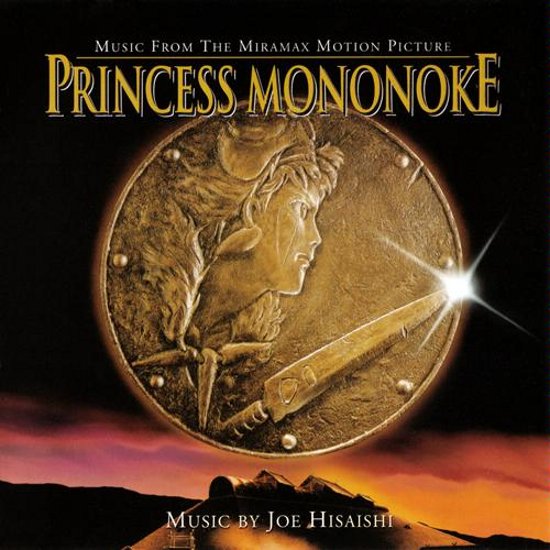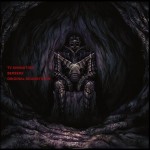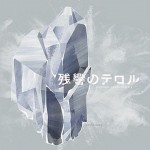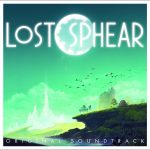One year ago, OSV’s inaugural “Soundtrack of the Month” was the score for Joe Hisaishi’s Nausicaä of the Valley of the Wind. This classic anime, based on a long series of manga-style graphic novels, was released in 1984 in Japan. Thirteen years later, Miyazaki-san decided to attempt the “man vs. nature” plot type again. But this time, instead of a post-apocalyptic fantasy world, he used the historical backdrop of 15th-century Japan, but still included plenty of mythical creatures and fantasy. And, of course, Miyazaki’s trustworthy film score composer, Joe Hisaishi, was along for the ride.
Today’s soundtrack of the month may be understood as a fitting reprisal. The only Miyazaki film, and soundtrack, darker and more shocking than Nausicaä has got to be Princess Mononoke. After the jump, our full review of this classic soundtrack, which you can pick up in Japan, Europe, or America with relative ease.
Check out this mammoth tracklist. 32 tracks, yikes!
01 The Legend of Ashitaka
02 The Demon God
03 Departure – To the West
04 Demon Power
05 The Land of the Impure
06 The Encounter
07 Kodamas
08 The Forest of the God
09 Evening at the Ironworks
10 The Demon God II – The Lost Mountains
11 Lady Eboshi
12 The Tatara Women Work Song
13 The Furies
14 The Young Man from the East
15 Requiem
16 Will to Live
17 San and Ashitaka in the Forest of the Deer God
18 Princess Mononoke Theme Song (Instrumental Version)
19 Requiem II
20 Battle Drums
21 The Battle in Front of the Ironworks
22 Demon Power II
23 Requiem III
24 Retreat
25 The Demon God III
26 Adagio of Life and Death
27 The World of the Dead
28 The World of the Dead II
29 Adagio of Life and Death II
30 Ashitaka and San
31 Princess Mononoke Theme Song
32 The Legend of Ashitaka Theme (End Credit)
There is one difference to the tracklist if you pick up the Japanese or French versions of the album: an inserted track 20, featuring a lengthened version of the vocal track “Princess Mononoke Theme Song,” is to be found. Also, the American version has an English version of said song, performed by Sasha Lazard. The original Japanese recording (also found on the French version of the album) is actually performed by a male counter-tenor, Yoshikazu Mera.
Regardless of version (though I recommend American version primarily for its price and availability), this soundtrack is an almost indispensable item in my personal collection. Any self-professed anime lover, particularly the Miyazaki fans out there, ought to own this album. Let me tell you why.
Despite there being 30-some tracks (give or take, depending on version) on this album, there are really no more than about 10 musical motifs. The most common is the theme found in “The Legend of Ashitaka,” and the next-most common is the melody of the vocal “Princess Mononoke Theme.” These two themes are interwoven so many times throughout the soundtrack: sometimes blatantly, sometimes subtly. You will find the musical representation of these two characters scattered all throughout the soundtrack. After all, Ashitaka (the film’s protagonist) and San (the given name for the film’s namesake, Princess Mononoke) are the stars of the show, and most scenes throughout the film feature at least one, if not both, of them.
If this anime were an RPG, the tense action scenes would be “battle themes,” and there are only a few of them, but they are often repeated. “Demon Power” officially appears twice on the album, but the melody can be found far more often than that. “Battle Drums” is another good one.
Other, lesser themes (the melody for “Tatara Women’s Work Song,” which is a Japanese group vocal) can also be found scattered in different places. There are only a few tracks that feature melodies contained only within itself. One is the enigmatic and charming “Kodamas” theme, which fits the artistic design for these lovable little ethereal creatures quite well. Another is “The World of the Dead” (and part II, which go hand in hand), featuring some strange, non-musical voice work, including someone saying “myawwh, myawwh!” (this is the scariest noise I’ve ever heard in my life…I love it!).
One theme that never really caught on until very recently, when I dug out my CD and listened through a few more times to write this review, is “Lady Eboshi.” Along with including the Ashitaka theme near the end of the track, the motif for Eboshi herself is quite memorable. If you can remember the scene where you hear this piece in the film (the “we take care of lepers” scene), you may remember just how powerful the dialogue is here. The music that goes hand-in-hand with this scene, I’d always ignored, until today. Now I feel quite strongly about it, and I’m glad I finally paid attention to this subtle, beautiful piece of music.
But I cannot stress this enough, the Ashitaka theme, which appears so many times on the album, is one of Hisaishi’s best compositions to date. The melody is so simple, but it is not a common melody. The five minute end credits version is the place to hear it in full. Another place to hear it, though, is on the “Symphonic Suite” recording, an 8-track album with extended versions of the motifs from the OST. That’s another great album to pick up, though only a Japanese version exists, and it’s quite a rare and expensive find these days.
We’ll try to hold back on our Hisaishi/Miyazaki love for the time being, but they both deserve a lot of love. The concert writeup we posted on OSV a few months back, as well as the Nausicaä SotM update, are just some examples of why we love Hisaishi’s work with Miyazaki so much. In 2010, maybe we’ll pick another one of Hisaishi’s fantastic scores for SotM. Until then, be sure to get this particular album into your collection. You won’t regret it.
Tags: Hisaishi, Miyazaki, Princess Mononoke, Reviews, Soundtrack of the Month, Studio Ghibli









































[…] See the rest here: Soundtrack of the Month 06/2009: Princess Mononoke […]
Princess Mononoke is one of the best movies I’ve watched. Period.
Huh, never saw the artwork for this album. Pretty sweet looking. I’m wondering if I should ban you from opening with the track lists. It’s over half the article!
Seriously? Does it matter?
Good read, Pat.
[…] to hear the game’s score, as most of us here at huge fans of Joe Hisaishi (see our Ponyo, Princess Mononoke, Nausicaa, and Ghibli concert […]